英语教学法知识点整理教学文稿
(完整版)《英语教学法》unit_1_language_and_learning
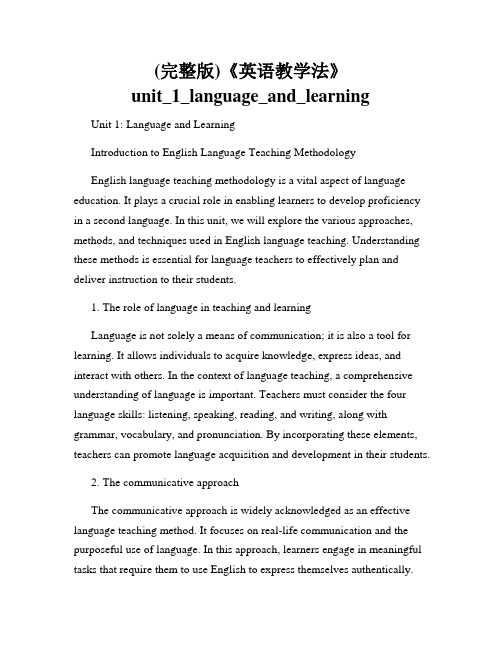
(完整版)《英语教学法》unit_1_language_and_learning Unit 1: Language and LearningIntroduction to English Language Teaching MethodologyEnglish language teaching methodology is a vital aspect of language education. It plays a crucial role in enabling learners to develop proficiency in a second language. In this unit, we will explore the various approaches, methods, and techniques used in English language teaching. Understanding these methods is essential for language teachers to effectively plan and deliver instruction to their students.1. The role of language in teaching and learningLanguage is not solely a means of communication; it is also a tool for learning. It allows individuals to acquire knowledge, express ideas, and interact with others. In the context of language teaching, a comprehensive understanding of language is important. Teachers must consider the four language skills: listening, speaking, reading, and writing, along with grammar, vocabulary, and pronunciation. By incorporating these elements, teachers can promote language acquisition and development in their students.2. The communicative approachThe communicative approach is widely acknowledged as an effective language teaching method. It focuses on real-life communication and the purposeful use of language. In this approach, learners engage in meaningful tasks that require them to use English to express themselves authentically.The communicative approach encourages learners to develop their fluency and accuracy by providing opportunities for interaction and authentic communication.3. The lexical approachThe lexical approach emphasizes the importance of teaching vocabulary and collocations in language learning. It recognizes that grammar and vocabulary are interconnected and that learners must acquire both to communicate effectively. Teachers following the lexical approach prioritize teaching high-frequency and useful vocabulary, as well as the collocations and phrases associated with them. By developing a strong lexical repertoire, learners can enhance their language proficiency and understanding.4. Task-based language teachingTask-based language teaching (TBLT) is a learner-centered approach that focuses on the completion of meaningful tasks. In TBLT, learners are presented with a task that requires the use of language to accomplish a specific goal. These tasks can be simulations of real-life situations or problem-solving activities. By engaging in these tasks, learners develop their language skills while also achieving the task objective. TBLT promotes both language acquisition and the development of critical thinking and problem-solving skills.5. Technology-enhanced language teachingTechnology has revolutionized language teaching and learning. It provides teachers and learners with access to an array of digital resources and tools. Technology-enhanced language teaching encompasses the use ofeducational software, online platforms, multimedia materials, and interactive activities. It enhances learner engagement and provides opportunities for independent learning. Integration of technology in language teaching opens up new possibilities for personalized and adaptive instruction.ConclusionEnglish language teaching methods continually evolve to meet the needs of diverse learners. It is essential for language teachers to keep abreast of current approaches and techniques to maximize instructional effectiveness. The approaches discussed in this unit, including the communicative approach, lexical approach, task-based language teaching, and technology-enhanced language teaching, provide teachers with valuable frameworks to deliver comprehensive and engaging language instruction. By applying these methods, language teachers can foster language learning and promote language proficiency development in their students.(Word count: 585)。
英语教学法教程知识点总结(1-12单元).doc
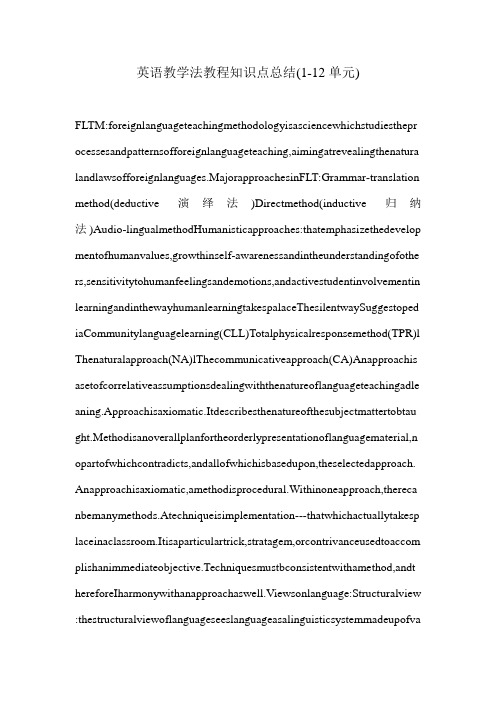
英语教学法教程知识点总结(1-12单元)FLTM:foreignlanguageteachingmethodologyisasciencewhichstudiesthepr ocessesandpatternsofforeignlanguageteaching,aimingatrevealingthenatura landlawsofforeignlanguages.MajorapproachesinFLT:Grammar-translation method(deductive演绎法)Directmethod(inductive归纳法)Audio-lingualmethodHumanisticapproaches:thatemphasizethedevelop mentofhumanvalues,growthinself-awarenessandintheunderstandingofothe rs,sensitivitytohumanfeelingsandemotions,andactivestudentinvolvementin learningandinthewayhumanlearningtakespalaceThesilentwaySuggestoped iaCommunitylanguagelearning(CLL)Totalphysicalresponsemethod(TPR)l Thenaturalapproach(NA)lThecommunicativeapproach(CA)Anapproachis asetofcorrelativeassumptionsdealingwiththenatureoflanguageteachingadle aning.Approachisaxiomatic.Itdescribesthenatureofthesubjectmattertobtau ght.Methodisanoverallplanfortheorderlypresentationoflanguagematerial,n opartofwhichcontradicts,andallofwhichisbasedupon,theselectedapproach. Anapproachisaxiomatic,amethodisprocedural.Withinoneapproach,thereca nbemanymethods.Atechniqueisimplementation---thatwhichactuallytakesp laceinaclassroom.Itisaparticulartrick,stratagem,orcontrivanceusedtoaccom plishanimmediateobjective.Techniquesmustbconsistentwithamethod,andt hereforeIharmonywithanapproachaswell.Viewsonlanguage:Structuralview :thestructuralviewoflanguageseeslanguageasalinguisticsystemmadeupofvarioussubsystems:thesoundsystem(phonology);thediscreteunitsofmeaningp roducedbysoundcombinations(morphology);andthesystemofcombininguni tsofmeaningforcommunication(syntax).Functionalview:thefunctionalview notonlyseeslanguageasalinguisticsystembutalsomeansfordoingthings.Fun ctionalactivities:offering,suggesting,advising,apologizing,etc.Internationa lview:considerslanguagetobeacommunicativetool,whosemainuseistobuild upandmaintainsocialrelationsbetweenpeople.Therefore,learnersnotonlyne edtoknowthegrammarandvocabularyofthelanguagebutasimportantlytheyn eedtoknowtherulesforusingtheminawholerangeofcommunicativecontexts. Process-orientedtheories:areconcernedwithhowthemindorganizesnewinfor mationsuchashabitformation,induction,makinginference,hypothesistesting andgeneralization.Condition-orientedtheories:emphasizethenatureofthehu manandphysicalcontextinwhichlanguagelearningtakesplace,suchasthenum berofstudents,thekindofinputlearnersreceives,andtheatmosphere.Behavior isttheory,theideaofthismethodisthatlanguageislearnedbyconstantrepletiona ndthereinforcementoftheteacher.Mistakeswereimmediatelycorrected,andc orrectutteranceswereimmediatelypraised.Cognitivetheory,languageisnotaf ormofbehavior,itisanintricaterule-basedsystemandalargepartoflanguageac quisitionisthelearningofthissystem.Constructivisttheory,believesthatlearni ngisaprocessinwhichthelearnerconstructsmeaningbasedonhis/herownexpe riencesandwhathe/shealreadyknows.Socio-constructivisttheory,similartoc onstructivisttheory,socio-constructivisttheoryemphasizesinteractionandengagementwiththetargetlanguageinasocialcontextbasedontheconceptof“Zo neofProximalDevelopment”(ZPD)andscaffolding.Ethicdevotion,professio nalqualitiesandpersonalstylesCLT:communicativelanguageteachingTBLT: task-basedlanguageteachingThegoalofCLTistodevelopstudents’communicativecompetence,whichincludesboththeknowledgeaboutthelang uageandtheknowledgeabouthowtousethelanguageappropriatelyincommun icativesituations.P16Hedgediscussesfivemaincomponentsofcommunicativ ecompetence:linguisticcompetence,pragmaticcompetence,discoursecomp etence,strategiccompetence,andfluency.Howattproposesaweakandastrong versionofCLT.Weakversion:learnersfirstacquirelanguageasastructuralsyste mandthenlearnhowtouseitincommunication.---theweakversionregardsover tteachingoflanguageformsandfunctionsasnecessarymeansforhelpinglearne rstodeveloptheabilitytousethemforcommunication.Strongversion:languag eisacquiredthroughcommunication.Thelearnersdiscoverthestructuralsyste mintheprocessofleaninghowtocommunicate.---regardsexperiencesofusingt helanguageasthemainmeansornecessaryconditionsforlearningalanguageast heyprovidetheexperienceforlearnerstoseehowlanguageisusedincommunic municativeactivities:P24Tasksareactivitieswherethetargetlangu ageisusedbytheleanerforacommunicativepurpose(goal)inordertoachievean outcome.Fourcomponentsofatask:apurpose,acontext,aprocess,andaproduc tTasksfocusonthecompleteactofcommunication.(Purposefulaccuracywork ---needtointervenemoreHowtocorrect:directteachercorrection,indirectteachercorrection,self-correction,peercorrection,wholeclasscorrection.Goaloft eachingpronunciation:Consistency:thepronunciationshouldbesmoothandn aturalIntelligibility:thepronunciationshouldbeunderstandabletothelisteners Communicativeefficiency:thepronunciationshouldhelpconveythemeaningt hatisintendedbythespeaker.Aspectsofpronunciation:besidessoundsandpho neticsymbols,suchasstress(strongandweakform,wordstressandsentencestre ss),intonationandrhythm(variation).Perceptionpractice:usingminimalpairs, whichorder,sameordifferent?Oddandout,Completion.Productionpractice:li stenandrepeat,filltheblanks,makeupsentences,usemeaningfulcontext,usepi cture,usetonguetwisters.Grammarpresentation:Thedeductivemethod,thein ductivemethod,theguideddiscoverymethodGrammarpractice:mechanicalp racticeandmeaningful/communicativepractice.Mechanicalpractice:involve sactivitiesthatareaimedatformaccuracy.Studentspayrepeatedattentiontoake yelementinastructure.Substitutiondrillandtransformationdrills.Meaningful practice:focusontheproduction,comprehensionorexchangeofmeaningthou ghthestudentskeepaneyeonthewaynewlylearnedstructuresareusedinthepro cess.Itcomesaftermechanicalpractice.(Comparativesandsuperlatives).Usin gpictureprompts,usingmimesorgesturesasprompts,usinginformationsheeta sprompts,usingkeyphrasesorkeywordsasprompts,usingchainedphrasesfors torytelling,usingcreatedsituations.Whatdoesknowingawordinvolve?Denot ativemeaning;connotativemeaning;chunk/collocations;synonyms,antony msandhyponyms;receptiveandproductivevocabulary.Denotativemeaningofawordoralexicalitemreferstothosewordsthatweusetolabelthingsasregardsr ealobjects,suchasanameorasign,etc.inthephysicalworld.Primarymeaningof aword.Aconnotativemeaningofawordreferstotheattitudesoremotionsofalan guageuserinchoosingawordandtheinfluenceoftheseonthelistenerorreader’sinterpretationoftheword.Collocationsrefertowordsthatco-occurwithhighfr equencyandhavebeenacceptedaswaysfortheuseofwords.Forinstance,see,lo okat,watch.Hyponymsrefertowordswhichcanbegroundedtogetherunderthe samesuperordinateconcept.Receptive/passivevocabularyreferstowordsthat oneisabletorecognizeandcomprehendinreadingorlisteningbutunabletousea utomaticallyinspeakingorwriting.Thosewordsthatoneisnotonlyabletorecog nizebutalsoabletouseinspeechandwritingareconsideredasone’sproductive/activevocabulary.Waysofpresentingvocabulary:inductiveandd eductive.Waysofconsolidatingvocabulary:labeling;spotthedifference;descr ibeanddraw;playagame;usewordsseries;wordbingo;wordassociation;findin gsynonymsandantonyms;categories;usingwordnet-work;usingtheinternetr esourcesformoreideas.Developingvocabularylearningstrategies:reviewreg ularly,guessmeaningfromcontext,organizevocabularyeffectively,useadicti onary,andmanagestrategyuse.Principlesandmodelsforteachinglistening:foc usonprocess,combinelisteningwithotherskills(listeningcanbepracticewithn ot-taking,andanswers,roleplays,retelling,interviewing,discussions,orawriti ngtask),focusonthecomprehensionofmeaning,gradedifficultylevelappropri ately,principlesforselectingandusinglisteningactivities.Twoapproachesarefrequentlyusedtodescribedifferentprocessesoflistening.Bottom-upmodelan dTop-downmodel.Bottom-upmodel:从细节入手startwithsoundandmeaningrecognitions.Listenersconstructmeaningofwhat theyhearbasedonthesoundtheyhear,expectthelistenershaveaveryeffectivesh ort-termmemoryastheyhavetomakesenseofeverysoundinordertofigureoutt hemeaningofwords,phrase,andstructures.Ifthereareunfamiliarsounds,listen erswillfinditverydifficulttokeepupwithspeaker.---recognizingsoundsofwor ds,phrasesorstructures.Top-downmodel:着重概要listeningforgistandmakinguseofthecontextualcluesandbackgroundknowle dgetoconstructmeaningareemphasized.Listenerscanunderstandbetterifthey alreadyhavesomeknowledgeintheirmindaboutthetopic.Suchknowledgeisal sotermedaspriorknowledgeorschematicknowledge---mentalframeworksfo rvariousthingsandexperienceweholdinourlong-termmemory.---referringm eaningfrombroadcontextualcluesandbackgroundknowledge.Threeteaching stages:pre-listening—warmingup;while-listening---listeningcomprehensio n;post-listening---checkinganswers.TeachingspeakingLesscomplexsyntax, shortcuts,incompletesentences,devicessuchasfillers,hesitationdevicetogive timetothinkingbefore。
教师读书笔记 《英语教学法》(上)(下)课程教学重点、难点及要求

教师读书笔记《英语教学法》(上)(下)课程教学重点、难点及要求心得随笔 Unit 1导论1.学习理论:行为主义学习理论,认知学习理论和结构学习理论;2.Krashen有关第二语言习得的5个假说,“学习”与“习得”的不同,包括Ellis的Instructed Second Language Acquisition,以及对外语教学的启示;3.外语教学发展史。
要求掌握各教学法的理论基础、课堂操作方式、适合的教学内容和教学对象以及优缺点等;4.课程设置,各类大纲和课程之间的关系,评估现行中学英语教材。
掌握LARA策略,合理使用教材为教学服务;5.需求分析理论(Needs Analysis)以及在教学中的运用;6.教师的自我发展,包括教师职业素质的构成,教师自我发展的途径;7.教学策略理论:教学策略的内涵和教学策略的组成。
Unit 2交际法1.交际教学法产生的背景;2.交际的内涵以及对教学的启示;3.交际教学法的原则及特征;4.交际教学法的教学目标;5.交际能力的内涵;6.不同学者对交际教学法的诠释;7.交际教学中教师和学生的角色;8.交际教学对学习材料的要求,“真实”材料的运用;9.交际教学课堂活动的安排,所采用的教学模式;10.交际活动的内容;11.根据自己的教材设计一堂交际教学课。
Unit 3阅读教学1.“阅读”的内涵,掌握有关阅读的几种观点,包括心理猜测理论和互动阅读理论。
2.影响有效/流畅阅读的因素;3.有关良好阅读者的研究;4.阅读教学中学生动机的激发;5.阅读教学模式:top-down approach, bottom-up approach 和interactive approach;各模式的理论依据,课堂操作方式,优缺点等;6.阅读的层次,包括read the lines, read between the lines 和 read beyond the lines (plain sense reading, deductive reading, projective reading)。
(完整word版)英语教学法教程知识点总结(1-12单元),推荐文档
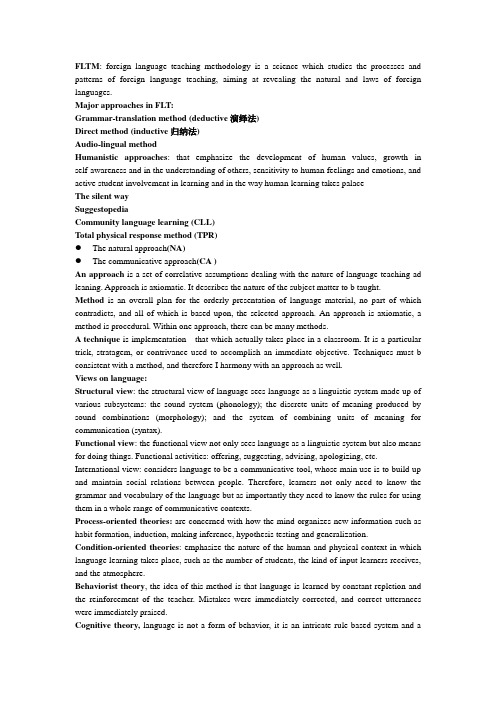
FLTM: foreign language teaching methodology is a science which studies the processes and patterns of foreign language teaching, aiming at revealing the natural and laws of foreign languages.Major approaches in FLT:Grammar-translation method (deductive演绎法)Direct method (inductive归纳法)Audio-lingual methodHumanistic approaches: that emphasize the development of human values, growth in self-awareness and in the understanding of others, sensitivity to human feelings and emotions, and active student involvement in learning and in the way human learning takes palaceThe silent waySuggestopediaCommunity language learning (CLL)Total physical response method (TPR)●The natural approach(NA)●The communicative approach(CA )An approach is a set of correlative assumptions dealing with the nature of language teaching ad leaning. Approach is axiomatic. It describes the nature of the subject matter to b taught.Method is an overall plan for the orderly presentation of language material, no part of which contradicts, and all of which is based upon, the selected approach. An approach is axiomatic, a method is procedural. Within one approach, there can be many methods.A technique is implementation---that which actually takes place in a classroom. It is a particular trick, stratagem, or contrivance used to accomplish an immediate objective. Techniques must b consistent with a method, and therefore I harmony with an approach as well.Views on language:Structural view: the structural view of language sees language as a linguistic system made up of various subsystems: the sound system (phonology); the discrete units of meaning produced by sound combinations (morphology); and the system of combining units of meaning for communication (syntax).Functional view: the functional view not only sees language as a linguistic system but also means for doing things. Functional activities: offering, suggesting, advising, apologizing, etc. International view: considers language to be a communicative tool, whose main use is to build up and maintain social relations between people. Therefore, learners not only need to know the grammar and vocabulary of the language but as importantly they need to know the rules for using them in a whole range of communicative contexts.Process-oriented theories: are concerned with how the mind organizes new information such as habit formation, induction, making inference, hypothesis testing and generalization.Condition-oriented theories: emphasize the nature of the human and physical context in which language learning takes place, such as the number of students, the kind of input learners receives, and the atmosphere.Behaviorist theory, the idea of this method is that language is learned by constant repletion and the reinforcement of the teacher. Mistakes were immediately corrected, and correct utterances were immediately praised.Cognitive theory, language is not a form of behavior, it is an intricate rule-based system and alarge part of language acquisition is the learning of this system.Constructivist theory, believes that learning is a process in which the learner constructs meaning based on his/her own experiences and what he/she already knows.Socio-constructivist theory, similar to constructivist theory, socio-constructivist theory emphasizes interaction and engagement with the target language in a social context based on the concept of “Zone of Proximal Development” (ZPD) and scaffolding.Ethic devotion, professional qualities and personal stylesCLT: communicative language teachingTBLT: task-based language teachingThe goal of CLT is to develop students’communicative competence, which includes both the knowledge about the language and the knowledge about how to use the language appropriately in communicative situations. P16Hedge discusses five main components of communicative competence: linguistic competence, pragmatic competence, discourse competence, strategic competence, and fluency.Howatt proposes a weak and a strong version of CLT.Weak version: learners first acquire language as a structural system and then learn how to use it in communication. --- the weak version regards overt teaching of language forms and functions as necessary means for helping learners to develop the ability to use them for communication.Strong version: language is acquired through communication. The learners discover the structural system in the process of leaning how to communicate.---regards experiences of using the language as the main means or necessary conditions for learning a language as they provide the experience for learners to see how language is used in communication.Communicative activities: P24Tasks are activities where the target language is used by the leaner for a communicative purpose (goal) in order to achieve an outcome.Four components of a task: a purpose, a context, a process, and a productTasks focus on the complete act of communication. (Purposeful & contextualized communication). Exercises focus the students’attention on the individual aspects of language, such as vocabulary, grammar or individual skills. (Focus on individual language items) Exercise-task comes halfway between tasks and exercises, consists of contextualized practice of language item.PPP: for teaching a new structure-based lesson, content lesson, presentation (introduces new vocabulary and grammatical structures), practice (the lesson moves from controlled practice to guided practice and exploitation of the texts when necessary) and production(the students are encouraged to use what they are learned and practiced to perform communicative tasks)The importance of lesson planning: 1. an unprepared teacher begins of a disastrous lesson.2. An unprepared teacher receives less trust and cooperation from the students. 3. The students are different, the time is different, and the mood is different.Lesson Planning: is a framework of a lesson in which teachers make advance decisions about what they hope to achieve and how they would like to achieve it. In other words, teachers need to think about the aims to be achieved, materials to be covered, activities to be organized, and techniques and resources to be used in order to achieve the aims of the lesson.Principles for good lesson planning: aim, variety, flexibility, learnability, and linkage. Variety: planning a number of different types of activities and where possible,introducing students to a wide selection of materials so that learning is always interesting, motivating and never monotonous for the students.Flexibility: preparing some extra and alternative tasks and activities at the class does not always go according to the plan so that teachers always have the option to cope with the unexpected situations rather than being the slaves of written plans or one methodology. Learnability:within capability of the students, not be too easy or beyond or below the students’ coping ability.Linkage: easy task followed by a comparatively difficult one, or do a series of language-focused activities to get the students prepared linguistically.Components of a lesson planning: background information, teaching aims, language content and skills, stages and procedures, teaching aids, assignments, and teacher’s after-lesson reflection.For skill-oriented lesson, focusing on developing skills, the model is applicable---pre-(reading), while-, post-. (Pre-step, while-step, post-step)Classroom management is the way teachers organize what goes on in the classroom.The role of the teacher: controller, assessor (evaluator, correcting mistakes and organizing feedback), organizer (organize and design task that students can perform in the class), prompter推动者(give appropriate prompts and give hints), participant, resource-provider, teacher’s new roles.There are rules to follow for making instructions effective.●The first is to use simple instructions and make them suit the comprehensive level of thestudents.●The second rule is to use the mother-tongue only when it is necessary.●Give students time to get used to listening to English instructions and help the make an effortto understand them.●Use body language to assist understanding and stick to it each time you teach the class. Student grouping: whole class group—same activity at the same rhythm and pace, lockstep, pair work, group work, individual studyDiscipline: refers to a code of conduct which binds a teacher and a group of students together so that learning can be more effective.Questioning in the classroom:Classification of question types: 1.closed questions and open questions 2.display questions and genuine questions 3.lower-order questions and higher-order questions 4.taxonomyClosed questions refer to those with only one s ingle correct answer while open questions may invite many different answers.Display questions are those that the answers are already known to the teacher and they are used for checking if students know the answer, too. Genuine questions are questions which are used to find out new information and since they often reflect real context, they are more communicative. Lower-order questions refer to those that simple require recalling of information or memorization of facts while higher order questions require more reasoning, analysis, and evaluation.Simple question and difficult questionA mistake refers to a performance error that is either a random guess or an “a slip of tongue”, it’s a failure performance to a known system.An error has direct relation with the learners’language competence. Results from Lack of knowledge in the target language. Language error cannot be self-corrected no matter how much attention is paidDealing with spoken errors: tasks or activities are focusing on accuracy or fluency. Balance between accuracy-based activities and fluency-based activities..When to correct: fluency work---not to interrupt, after the student’s performance; accuracy work---need to intervene moreHow to correct: direct teacher correction, indirect teacher correction, self-correction, peer correction, whole class correction.Goal of teaching pronunciation:Consistency: the pronunciation should be smooth and naturalIntelligibility: the pronunciation should be understandable t o the listenersCommunicative efficiency: the pronunciation should help convey the meaning that is intended by the speaker.Aspects of pronunciation: besides sounds and phonetic symbols, such as stress (strong and weak form, word stress and sentence stress), intonation and rhythm (variation).Perception practice: using minimal pairs, which order, same or different? Odd and out, Completion.Production practice: listen and repeat, fill the blanks, make up sentences, use meaningful context, use picture, use tongue twisters.Grammar presentation: The deductive method, the inductive method, the guided discovery methodGrammar practice: mechanical practice and meaningful/ communicative practice.Mechanical practice: involves activities that are aimed at form accuracy. Students pay repeated attention to a key element in a structure. Substitution drill and transformation drills.Meaningful practice: focus on the production, comprehension or exchange of meaning though the students keep an eye on the way newly learned structures are used in the process. It comes after mechanical practice. (Comparatives and superlatives). Using picture prompts, using mimes or gestures as prompts, using information sheet as prompts, using key phrases or key words as prompts, using chained phrases for story telling, using created situations.What does knowing a word involve? Denotative meaning; connotative meaning; chunk/collocations; synonyms, antonyms and hyponyms; receptive and productive vocabulary.Denotative meaning of a word or a lexical item refers to those words that we use to label things as regards real objects, such as a name or a sign, etc. in the physical world. Primary meaning of a word.A connotative meaning of a word refers to the attitudes or emotions of a language user in choosing a word and the influence of these on the listener or reader’s interpretation of the word.Collocations refer to words that co-occur with high frequency and have been accepted as ways for the use of words. For instance, see, look at, watch.Hyponyms refer to words which can be grounded together under the same superordinate concept. Receptive/passive vocabulary refers to words that one is able to recognize and comprehend in reading or listening but unable to use automatically in speaking or writing. Those words that one is not only able to recognize but also able to use in speech and writing are considered as one’s productive/active vocabulary.Ways of presenting vocabulary: inductive and deductive.Ways of consolidating vocabulary: labeling; spot the difference; describe and draw; play a game; use words series; word bingo; word association; finding synonyms and antonyms; categories; using word net-work; using the internet resources for more ideas.Developing vocabulary learning strategies: review regularly, guess meaning from context, organize vocabulary effectively, use a dictionary, and manage strategy use.Principles and models for teaching listening: focus on process, combine listening with other skills (listening can be practice with not-taking, and answers, role plays, retelling, interviewing, discussions, or a writing task), focus on the comprehension of meaning, grade difficulty level appropriately, principles for selecting and using listening activities.Two approaches are frequently used to describe different processes of listening.Bottom-up model and Top-down model.Bottom-up model: 从细节入手start with sound and meaning recognitions. Listeners construct meaning of what they hear based on the sound they hear, expect the listeners have a very effective short-term memory as they have to make sense of every sound in order to figure out the meaning of words, phrase, and structures. If there are unfamiliar sounds, listeners will find it very difficult to keep up with speaker. ---recognizing sounds of words, phrases or structures.Top-down model: 着重概要listening for gist and making use of the contextual clues and background knowledge to construct meaning are emphasized. Listeners can understand better if they already have some knowledge in their mind about the topic. Such knowledge is also termed as prior knowledge or schematic knowledge---mental frameworks for various things and experience we hold in our long-term memory. ---referring meaning from broad contextual clues and background knowledge.Three teaching stages: pre-listening—warming up; while-listening---listening comprehension; post-listening---checking answers.Teaching speakingLess complex syntax, short cuts, incomplete sentences, devices such as fillers, hesitation device to give time to thinking before speaking, false start, spontaneous, time-constraint.Types of speaking: pre-communicative activities—mechanical activities; communicative activities---meaningful activities.Controlled activities, semi-controlled activities, communicative activities:Information-gap activities; dialogues and role-plays; activities using pictures; problem-solving activities; change the story; human scrabbleOrganizing speaking tasks: use small group workTeaching readingThe construction of meaning from a printed or written message.Two broad levels in the act reading.1). A recognition task of perceiving visual signals from the printed page through the eyes.2). A cognitive task of interpreting the visual information revealing the received information with the reader’s own general knowledge, and reconstructing the meaning that the writer had meant to convey.For teaching: intensive/extensive readingIn terms of methods: skimming/scanning/predictingFor reading practice: reading aloud/silent readingThe role of vocabulary in reading: sight vocabulary: words that one is able to recognize immediately are often referred to as sight vocabulary.Principles and models for teaching reading: bottom-up model; top-down model; interactive modelPre-reading activities: predicting (predicting based on the tile/ based on vocabulary/based on the T/F questions) setting the scene, skimming, and scanningWhile-reading activities: TD (a transition device)Reading comprehension questions: 1. questions of literal comprehension 2. Questions involving reorganization or reinterpretation 3. Questions for inference (what is implied but not explicitly stated) 4. questions for evaluation or appreciation (making judgment about what the writer is trying to do and how successful he/she is in achieving his/her purpose) 5. Questions for personal responseIntensive reading is an accuracy-oriented activity involving reading for detail; the main purpose is to learn language embedded in the reading texts, which are usually short. Extensive reading is a fluency activity. The main purpose is to achieve global understanding. Te reading texts usually contains less new vocabulary and is longer than those intended for intensive reading.Teaching writingWriting for consolidating language, writing for communication, between writing for learning and writing for communication, imaginationNot have a real communicative purpose; for language skill; a little bit communicative; communicative approach; neither restrictions in contents nor in word limit; more communicative; more motivatedCA: communication approachA Productive approach to writing 成果法/a prose model approach---fruitlessA Process approach to writing 过程法: The teacher provides to guide students through the process that they undergo when they are writing. This kind of guidance should be gradually withdrawn so that the students can finally become independent writers.Main procedures of process writing include: creating a motivation to write, brainstorming, mapping, freewriting, outlining, drafting, editing, revising, proofreading and conferencing.。
英语教学法教程主要知识点归纳(K12教育文档)

英语教学法教程主要知识点归纳(word版可编辑修改)编辑整理:尊敬的读者朋友们:这里是精品文档编辑中心,本文档内容是由我和我的同事精心编辑整理后发布的,发布之前我们对文中内容进行仔细校对,但是难免会有疏漏的地方,但是任然希望(英语教学法教程主要知识点归纳(word版可编辑修改))的内容能够给您的工作和学习带来便利。
同时也真诚的希望收到您的建议和反馈,这将是我们进步的源泉,前进的动力。
本文可编辑可修改,如果觉得对您有帮助请收藏以便随时查阅,最后祝您生活愉快业绩进步,以下为英语教学法教程主要知识点归纳(word版可编辑修改)的全部内容。
Unit 1Knowledge: sth that can be learnedSkills: sth that only can be gained through practice or training, Language skills: listening, speaking, reading and writingLanguage is a system of arbitrary vocal symbols used for human communication。
Views on language:1、Structural view (language competence)—The founder: Saussure—The structural view of language sees language as a linguistic system made up of various subsystems:1、the sound system(phonology) 2、sound combinations (morphology)3、 meaning for communication(syntax)—Learning the language is to learn the structural items,study the inner structure and rule of language,ignore the social functions of the language.2 、Functional view— Representative: Johnson、marrow、swain canal (the core: grammar)—The function view not only sees language as a linguistic system but also a means for doing things-Learners learn a language in order to be able to doing things with itUse the linguistic structure to express functions3、Interactional view (communicative competence)— Emphasis:appropriateness— Language is a communicative tool,which main use is to build up and maintain social relations between people-Learners need to know the rules for using the language in certain context—The structural view limits knowing a language to knowing its structural rules and vocabularyLanguage teacher qualifications:1、a good command of spoken and written language2、formulate theory presupposition3、language background and experience4、know how languages are learnt5、the ability to use methods in various situations6、deep understanding of cultural background7、understanding the principles of teachingThese elements can be categorized into three groups:ethic devotion, professional qualities and personal stylesView on language learning1. Psycholinguistic: the relationship between language and thinking。
英语教学法教程主要知识点归纳

英语教学法教程主要知识点归纳
1. 教学法的概念和意义
- 教学法是指教师在教学过程中所采用的一系列组织和指导学生学习的方法和策略。
- 教学法对于提高教学效果和学生学习成果具有重要的影响。
2. 教学目标的设定和实施
- 设定明确的教学目标,包括知识、技能和态度等方面。
- 设计符合教学目标的教学活动和任务,以有效地实现教学目标。
3. 课堂组织和管理
- 设计合理的课堂结构,包括开头、主体和结尾等部分。
- 管理学生的行为和注意力,确保课堂秩序良好。
4. 教学方法的选择和运用
- 根据学生的特点和教学内容的要求,选择合适的教学方法,如讲授法、讨论法、合作学习法等。
- 运用多种教学方法,以促进学生的主动参与和积极学习。
5. 教学资源的利用
- 利用多种教学资源,如教材、多媒体工具、实物、图表等,丰富教学内容,提高学生的学习兴趣和理解能力。
6. 评价与反馈
- 设计合理的评价方式和评价标准,以评估学生的学习成绩和教学效果。
- 及时给予学生反馈,帮助他们纠正错误和进一步提高。
7. 多元化的教学策略
- 采用多种教学策略,如激发学生的兴趣和好奇心、引导学生
主动探究、启发学生的创造思维等,以提高教学效果。
8. 教学过程的设计和调整
- 设计完整的教学过程,包括课前导入、知识讲解、练习与巩固、课后复习等环节。
- 随时根据学生的学习情况和实际需要,调整教学过程和方法,以提高学习效果。
英语教学法教程主要知识点归纳

英语教学法教程主要知识点归纳英语教学法是针对学习英语的教师设计的一整套教学方法和策略的综合体系。
它涵盖了英语教学的理论基础、教学设计和实施、评估和反思等方面。
在英语教学过程中,教师需要掌握和运用一些基本的英语教学法,以便更有效地促进学生的语言学习。
本文将对英语教学法的主要知识点进行归纳,以供教师们参考和学习。
一、教学目标的设定1.确定清晰的语言学习目标:教师应该明确学生应该达到的语言能力水平,并将目标分解成可量化的具体目标。
2.编写明确的教学目标:教师需要将教学目标写成具体、可测量和可理解的语言任务,以帮助学生更好地理解和实现目标。
二、教学内容的选择和组织1.构建情境化的教学内容:通过创造真实的语言情境,激发学生的学习兴趣和动机,提高学习效果。
2.根据学生的兴趣选择教学内容:教师应该根据学生的兴趣和需要,选择与他们日常生活相关的话题和素材,使学习更贴近实际。
3.结合语法、词汇和语言技能进行教学:教师应该将语法、词汇和语言技能有机地结合起来,让学生能够在实际运用中灵活运用。
三、教学方法和策略的运用1.交互型教学方法:包括师生互动、学生间互动和学生自主学习,通过口语对话和实践活动培养学生的听说能力。
2.任务型教学方法:通过设置具体的任务来激发学生的学习兴趣和动力,培养学生的语言运用能力。
3.多媒体辅助教学:结合音频、视频和网络资源,提供多样化的教学材料和活动,增强学生的学习体验和参与度。
四、教学评估与反思1.形成性评价:通过课堂观察、作业评查和小组讨论等形式对学生进行及时的反馈和评估,帮助他们发现自己的差距并采取相应的学习策略。
2.总结性评价:通过考试、测验或教育性评估工具对学生的学习成果进行系统的评估,同时为教师提供改进教学的反馈。
五、教学环境的创设1.积极、鼓励的教学氛围:创造友好、开放、尊重和包容的教学环境,鼓励学生参与和表达,培养积极的学习态度。
2.多样化的学习资源:提供丰富多样的教学资源,包括教材、课外读物、在线学习平台等,满足学生的不同学习需求。
英语教学法教程手稿重点笔记
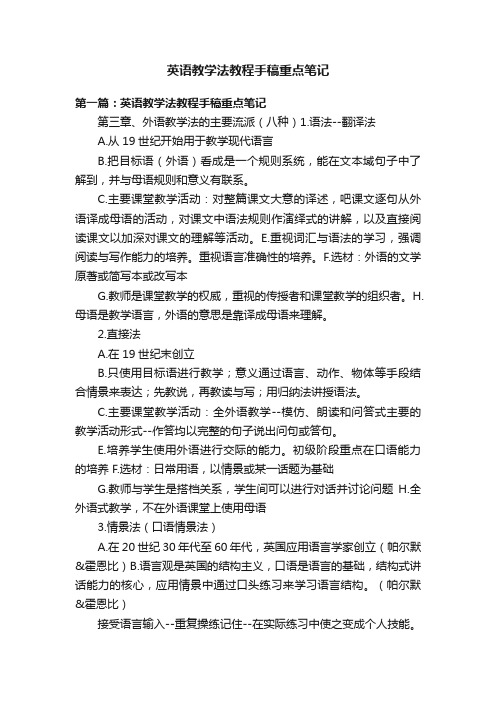
英语教学法教程手稿重点笔记第一篇:英语教学法教程手稿重点笔记第三章、外语教学法的主要流派(八种)1.语法--翻译法A.从19世纪开始用于教学现代语言B.把目标语(外语)看成是一个规则系统,能在文本域句子中了解到,并与母语规则和意义有联系。
C.主要课堂教学活动:对整篇课文大意的译述,吧课文逐句从外语译成母语的活动,对课文中语法规则作演绎式的讲解,以及直接阅读课文以加深对课文的理解等活动。
E.重视词汇与语法的学习,强调阅读与写作能力的培养。
重视语言准确性的培养。
F.选材:外语的文学原著或简写本或改写本G.教师是课堂教学的权威,重视的传授者和课堂教学的组织者。
H.母语是教学语言,外语的意思是靠译成母语来理解。
2.直接法A.在19世纪末创立B.只使用目标语进行教学;意义通过语言、动作、物体等手段结合情景来表达;先教说,再教读与写;用归纳法讲授语法。
C.主要课堂教学活动:全外语教学--模仿、朗读和问答式主要的教学活动形式--作答均以完整的句子说出问句或答句。
E.培养学生使用外语进行交际的能力。
初级阶段重点在口语能力的培养F.选材:日常用语,以情景或某一话题为基础G.教师与学生是搭档关系,学生间可以进行对话并讨论问题H.全外语式教学,不在外语课堂上使用母语3.情景法(口语情景法)A.在20世纪30年代至60年代,英国应用语言学家创立(帕尔默&霍恩比)B.语言观是英国的结构主义,口语是语言的基础,结构式讲话能力的核心,应用情景中通过口头练习来学习语言结构。
(帕尔默&霍恩比)接受语言输入--重复操练记住--在实际练习中使之变成个人技能。
(帕尔默)C.主要课堂教学活动:《新概念英语》提出情景--学习语言--听说领会--反复操练--书面练习--巩固结构E.培养学生听说读写的能力,口语是第一性的,是笔头语的基础,重视语音语法的准确性。
F.教师是语言楷模,课堂活动的设计者与指挥官,学生是模仿者G.英语是教学语言4.听说法A.在第二次世界大战期间由美国语言学家建立B.在语言学理论方面是以结构主义作为其理论的基础,以行为主义的学习理论作为依据语言技能的获得通过刺激--反应--强化的过程。
英语教学设计知识点总结

英语教学设计知识点总结英语教学设计是指为了实现教学目标,在教学过程中进行的有计划、有组织、有针对性的设计。
它是教育教学活动中不可或缺的一环,具有重要的指导意义和实践价值。
本文将总结英语教学设计的关键知识点,以帮助教师们更好地进行教学设计。
1. 教学目标的设定教学目标是教师设计教学活动的出发点和归宿点。
在英语教学设计中,教师应明确所要达到的语言知识和交际能力目标,并根据学生的英语水平和学习需求来设定合理的目标。
教学目标应具体、可衡量和可操作,以便教师能够评估学生的学习成果。
2. 教学内容的选择在英语教学设计中,教师需要根据教学目标来选择合适的教学内容。
教学内容应具有连贯性和渐进性,从简单到复杂,有助于学生逐步提高语言能力。
教师可以结合教材内容、学生的兴趣和实际情况,选择相关的话题、课文和练习,以激发学生的学习兴趣。
3. 教学方法与活动设计教学方法是指教师在教学过程中采用的具体教学手段和策略。
在英语教学设计中,教师应根据教学目标和学生的学习特点,选择合适的教学方法和活动。
例如,采用交际法、合作学习和情景教学等方法可以提高学生的口语表达能力和交际能力。
4. 任务设计与评估任务设计是指针对学生的学习需求和实际情况,设计适合的任务和活动。
任务设计应具有挑战性和启发性,可以激发学生的思维和动手能力。
在英语教学设计中,教师可以设计口语对话、听力理解、阅读理解和写作任务等,以提高学生的综合语言能力。
同时,教师应根据任务的完成情况,进行及时的评估和反馈,以帮助学生提高学习效果。
5. 教学资源的利用教学资源包括教材、多媒体设备、网络资源和教学工具等。
在英语教学设计中,教师应合理利用不同的教学资源,以增加教学的趣味性和效果。
教师可以使用教材中的例句和练习,引导学生进行语言输入和输出;利用多媒体设备呈现生动的教学内容;借助网络资源和教学工具提供更加个性化和灵活的学习方式。
6. 不同能力学生的差异化教学在英语教学设计中,教师应考虑学生的不同能力水平和学习特点,进行差异化教学。
英语教学法教程主要知识点归纳
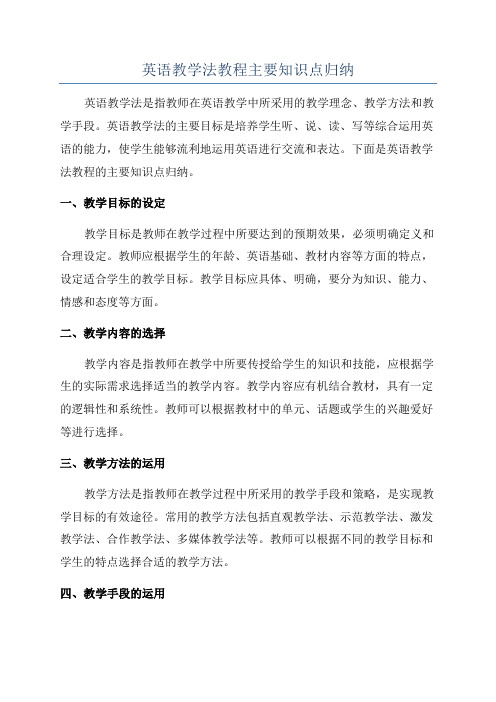
英语教学法教程主要知识点归纳英语教学法是指教师在英语教学中所采用的教学理念、教学方法和教学手段。
英语教学法的主要目标是培养学生听、说、读、写等综合运用英语的能力,使学生能够流利地运用英语进行交流和表达。
下面是英语教学法教程的主要知识点归纳。
一、教学目标的设定教学目标是教师在教学过程中所要达到的预期效果,必须明确定义和合理设定。
教师应根据学生的年龄、英语基础、教材内容等方面的特点,设定适合学生的教学目标。
教学目标应具体、明确,要分为知识、能力、情感和态度等方面。
二、教学内容的选择教学内容是指教师在教学中所要传授给学生的知识和技能,应根据学生的实际需求选择适当的教学内容。
教学内容应有机结合教材,具有一定的逻辑性和系统性。
教师可以根据教材中的单元、话题或学生的兴趣爱好等进行选择。
三、教学方法的运用教学方法是指教师在教学过程中所采用的教学手段和策略,是实现教学目标的有效途径。
常用的教学方法包括直观教学法、示范教学法、激发教学法、合作教学法、多媒体教学法等。
教师可以根据不同的教学目标和学生的特点选择合适的教学方法。
四、教学手段的运用教学手段是指教师在教学中所使用的具体工具和材料,有助于提高学生的学习效果和学习兴趣。
教学手段包括教学用具、多媒体设备、实物、图片、录音、录像等。
教师可以根据教学内容和学生的学习需求选择合适的教学手段。
五、教学评价的方法教学评价是指教师对学生学习情况和教学效果进行评估和判断的过程。
教学评价应注重全面、准确、客观和具体。
常用的教学评价方法包括测试、作业、观察、讨论、听说读写等。
教师可以根据教学目标和学生的实际情况选择合适的教学评价方法。
六、教学设计的步骤教学设计是指教师根据教学目标和教学要求所制定的教学过程和教学计划。
教学设计应包括教学目标、教学内容、教学方法、教学手段、教学评价等方面的内容。
教学设计的步骤包括分析教学内容和学生的学习需求、确定教学目标、设计教学过程和制定教学计划。
英语教学法期末知识点总结
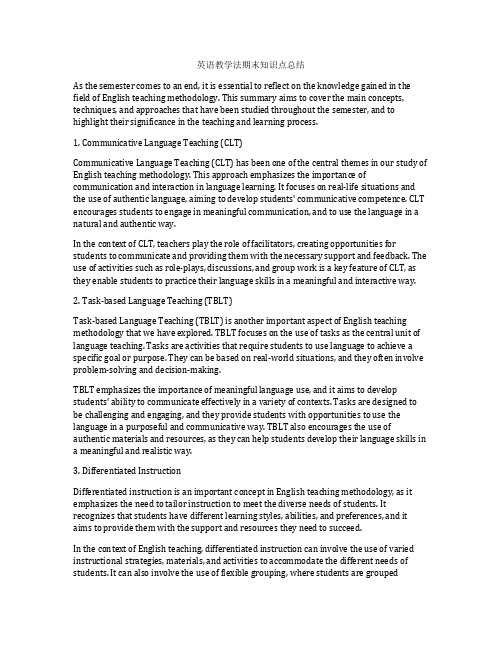
英语教学法期末知识点总结As the semester comes to an end, it is essential to reflect on the knowledge gained in the field of English teaching methodology. This summary aims to cover the main concepts, techniques, and approaches that have been studied throughout the semester, and to highlight their significance in the teaching and learning process.1. Communicative Language Teaching (CLT)Communicative Language Teaching (CLT) has been one of the central themes in our study of English teaching methodology. This approach emphasizes the importance of communication and interaction in language learning. It focuses on real-life situations and the use of authentic language, aiming to develop students' communicative competence. CLT encourages students to engage in meaningful communication, and to use the language in a natural and authentic way.In the context of CLT, teachers play the role of facilitators, creating opportunities for students to communicate and providing them with the necessary support and feedback. The use of activities such as role-plays, discussions, and group work is a key feature of CLT, as they enable students to practice their language skills in a meaningful and interactive way.2. Task-based Language Teaching (TBLT)Task-based Language Teaching (TBLT) is another important aspect of English teaching methodology that we have explored. TBLT focuses on the use of tasks as the central unit of language teaching. Tasks are activities that require students to use language to achieve a specific goal or purpose. They can be based on real-world situations, and they often involve problem-solving and decision-making.TBLT emphasizes the importance of meaningful language use, and it aims to develop students' ability to communicate effectively in a variety of contexts. Tasks are designed to be challenging and engaging, and they provide students with opportunities to use the language in a purposeful and communicative way. TBLT also encourages the use of authentic materials and resources, as they can help students develop their language skills ina meaningful and realistic way.3. Differentiated InstructionDifferentiated instruction is an important concept in English teaching methodology, as it emphasizes the need to tailor instruction to meet the diverse needs of students. It recognizes that students have different learning styles, abilities, and preferences, and it aims to provide them with the support and resources they need to succeed.In the context of English teaching, differentiated instruction can involve the use of varied instructional strategies, materials, and activities to accommodate the different needs of students. It can also involve the use of flexible grouping, where students are groupedaccording to their learning needs and preferences. By differentiating instruction, teachers can ensure that all students have the opportunity to learn and succeed, regardless of their individual differences.4. The Use of Technology in English TeachingThe use of technology has become an integral part of English teaching methodology. Technology can provide students with access to a wide range of resources and materials, and it can also enhance their learning experiences. In the context of English teaching, technology can be used to provide students with opportunities for independent practice, to facilitate communication and collaboration, and to provide access to authentic language use. In recent years, the use of technology in English teaching has expanded to include a wide range of tools and resources, including interactive whiteboards, multimedia resources, and online learning platforms. These technologies can provide students with engaging and interactive learning experiences, and they can also provide teachers with valuable resources for instruction and assessment.5. Assessment and Evaluation in English TeachingAssessment and evaluation are important components of English teaching methodology. They are essential for monitoring students' progress, providing feedback, and informing instructional decisions. In the context of English teaching, assessment can take many forms, including traditional tests and quizzes, as well as performance-based assessments and portfolios.In recent years, there has been an increasing emphasis on the use of authentic assessment in English teaching. Authentic assessment focuses on the assessment of real-life language use, and it aims to provide a more accurate and meaningful measure of students' language proficiency. Authentic assessment can include tasks and projects that require students to use the language in a purposeful and meaningful way, and it can provide a more accurate measure of students' ability to communicate effectively.In conclusion, the knowledge gained in the field of English teaching methodology has been extensive and diverse. The concepts, techniques, and approaches covered in this summary represent the key components of effective English teaching, and they highlight the importance of communicative, task-based, and differentiated instruction, the use of technology, and authentic assessment and evaluation in the teaching and learning process. By implementing these principles in the classroom, teachers can create engaging and effective learning experiences for their students, and they can help students develop the language skills they need to succeed in the real world.。
《英语教学法教程(第二版)》讲义
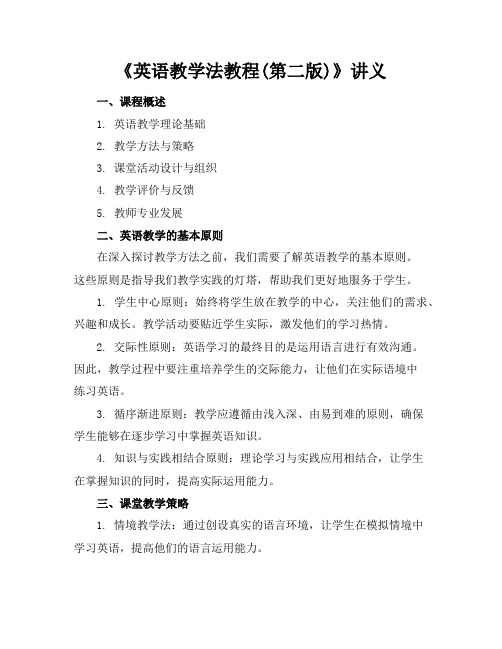
《英语教学法教程(第二版)》讲义一、课程概述1. 英语教学理论基础2. 教学方法与策略3. 课堂活动设计与组织4. 教学评价与反馈5. 教师专业发展二、英语教学的基本原则在深入探讨教学方法之前,我们需要了解英语教学的基本原则。
这些原则是指导我们教学实践的灯塔,帮助我们更好地服务于学生。
1. 学生中心原则:始终将学生放在教学的中心,关注他们的需求、兴趣和成长。
教学活动要贴近学生实际,激发他们的学习热情。
2. 交际性原则:英语学习的最终目的是运用语言进行有效沟通。
因此,教学过程中要注重培养学生的交际能力,让他们在实际语境中练习英语。
3. 循序渐进原则:教学应遵循由浅入深、由易到难的原则,确保学生能够在逐步学习中掌握英语知识。
4. 知识与实践相结合原则:理论学习与实践应用相结合,让学生在掌握知识的同时,提高实际运用能力。
三、课堂教学策略1. 情境教学法:通过创设真实的语言环境,让学生在模拟情境中学习英语,提高他们的语言运用能力。
2. 任务型教学法:以完成任务为目标,引导学生积极参与、合作探究,培养他们的团队协作能力和解决问题的能力。
3. 激励性评价:采用正面、鼓励性的评价方式,关注学生的进步和努力,激发他们的学习积极性。
4. 多元化教学手段:结合现代教育技术,运用多媒体、网络等资源,丰富教学手段,提高教学效果。
四、课堂活动实践2. 互动环节:设计小组讨论、角色扮演等活动,让学生在互动中提高英语听说能力。
3. 语言技能训练:针对听、说、读、写四个方面,设计专项训练活动,帮助学生全面提升英语能力。
通过本讲义的学习,希望您能在英语教学的道路上越走越远,为我国英语教育事业贡献自己的力量。
五、课程资源与材料的选择1. 教材选择:选用符合教学大纲、贴近学生实际、具有时代特色的教材。
同时,注意教材的难易程度,确保学生能够接受。
2. 辅助材料:充分利用网络资源、报刊杂志、影视作品等辅助材料,丰富教学内容,提高学生的学习兴趣。
教师资格证科目三-英语教学法知识点整理
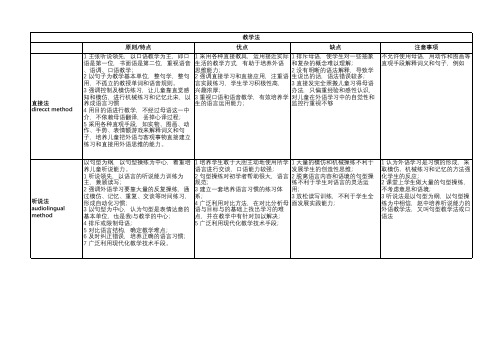
主,兼顾读写;
规范;
练不利于学生对语言的灵活运
2 强调外语学习要靠大量的反复操练,通 3 建立一套培养语言习惯的练习体 用;
过模仿、记忆、重复、交谈等时间练习, 系;
3 放松读写训练,不利于学生全
形成自动化习惯;
4 广泛利用对比方法,在对比分析母 面发展实践能力;
3 以句型为中心,认为句型是表情达意的 语与目标与的基础上找出学习的难
过程分为感知、理解、练习和活用四个步 能力;
骤;
4 不使用母语,通过实物、图片、手势等
直观手段直接教外语,使情景的意义与所
学的外语建立联系;
5 坚持口语领先和句子本位的原则,日常
生活情景对话使教学的中心,掌握正确的
语音、语调和口语语感;
6 广泛使用现代化技术设备,使儿童充分
运用视觉感官和听觉器官进行学习;
1 意义是第一位的; 2 课堂任务需要有明确的目标,即解决某 一交际问题; 3 活动的成果是可以被检验的; 4 任务应与真实世界和生活经验联系
任务型教学法 task-based language teaching approach
1 完成多种多样的任务活动,有助于 1 概念不清;
激发学生的学习兴趣;
听说法 audiolingual method
以句型为纲,以句型操练为中心,着重培 1 培养学生敢于大胆主动地使用所学 1 大量的模仿和机械操练不利于
养儿童听说能力。
语言进行交谈,口语能力较强; 发展学生的创造性思维;
1 听说领先,以语言的听说能力训练为 2 句型操练对初学者帮助很大,语言 2 脱离语言内容和语境的句型操
系性;
的言语,而且是根据功确定不同的目标,教
学活动的练习形式多样,采用二人、三人
英语教学法归纳
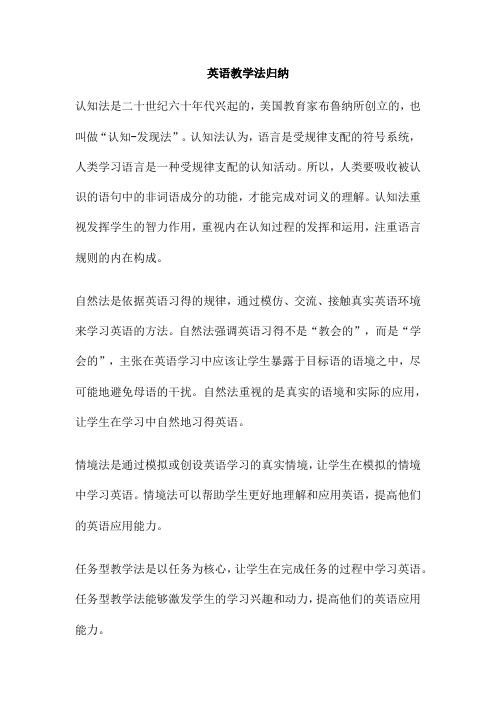
英语教学法归纳认知法是二十世纪六十年代兴起的,美国教育家布鲁纳所创立的,也叫做“认知-发现法”。
认知法认为,语言是受规律支配的符号系统,人类学习语言是一种受规律支配的认知活动。
所以,人类要吸收被认识的语句中的非词语成分的功能,才能完成对词义的理解。
认知法重视发挥学生的智力作用,重视内在认知过程的发挥和运用,注重语言规则的内在构成。
自然法是依据英语习得的规律,通过模仿、交流、接触真实英语环境来学习英语的方法。
自然法强调英语习得不是“教会的”,而是“学会的”,主张在英语学习中应该让学生暴露于目标语的语境之中,尽可能地避免母语的干扰。
自然法重视的是真实的语境和实际的应用,让学生在学习中自然地习得英语。
情境法是通过模拟或创设英语学习的真实情境,让学生在模拟的情境中学习英语。
情境法可以帮助学生更好地理解和应用英语,提高他们的英语应用能力。
任务型教学法是以任务为核心,让学生在完成任务的过程中学习英语。
任务型教学法能够激发学生的学习兴趣和动力,提高他们的英语应用能力。
全身反应法是通过身体动作等方式来学习英语。
全身反应法能够帮助学生更好地理解和记忆英语,同时能够提高他们的学习兴趣和参与度。
交际法是以交际为核心,让学生在交际中学习英语。
交际法重视的是学生的主动性和参与性,让学生在真实的交际环境中学习和应用英语。
以上六种教学法都有其独特的特点和适用范围,教师在教学过程中应该根据不同的教学需求和学生的特点选择合适的教学法来进行教学。
高中英语句型是英语学习的重要部分,掌握好这些句型可以帮助我们更好地理解英语语法,提高英语口语和写作能力。
下面是一些常见的高中英语句型归纳:这种句型通常用来表示行为或状态的基本情况或正在进行的动作。
例如:The sun is shining.(太阳正在照耀。
)这种句型表示行为或状态的结果,即主语对宾语产生了某种影响或结果。
例如:I like music.(我喜欢音乐。
)这种句型表示主语对两个宾语都产生了影响或结果。
英语教学法教程知识点总结

英语教学法教程知识点总结我跟你说啊,这英语教学法教程的知识点啊,那可真是有点意思。
就像那英语教学的目标,咱得让学生能真正把英语用起来,不能光会做题。
我就想起我以前见过的那些学生,一个个愁眉苦脸地对着那些英语卷子,那小眼神啊,就像看着什么洪水猛兽似的。
咱先说这教学方法里的语法翻译法。
这个方法啊,就像是一个老古董,有好的地方,也有不好的地方。
好的地方呢,就是能让学生很清楚地知道语法规则,就像给学生一把尺子,让他们去量那些英语句子。
但是啊,这学生学出来啊,就像个木头人,只会按照规则来,不会灵活运用。
我就问那些用这个方法教英语的老师,我说:“您这教出来的学生,咋都像机器人似的呢?”那老师也无奈啊,说:“这方法就这样,咱也没办法。
”再说说直接法吧。
这个方法就不一样了,就像一阵清风。
它强调直接用英语教英语,不用母语翻译。
我觉得这就对了嘛,学生就像一个个小树苗,直接在英语的环境里生长。
我见过一个外教用这个方法教小孩,那外教啊,长得高高大大的,一脸的笑容,眼睛就像星星似的。
他在教室里又蹦又跳的,拿着那些卡片,上面画着苹果啊、香蕉啊,就用英语说“apple”“banana”,那些小孩可高兴了,跟着他喊。
不过呢,这方法也有难处,对于那些基础不太好的学生来说,就像一下子被扔到了一个陌生的国度,有点不知所措。
还有视听法呢。
这个方法啊,就像是给学生打开了一扇通往英语世界的大门。
通过那些录像啊、音频啊,让学生能看到、听到最地道的英语。
我记得我在一个学校里看到他们用这个方法,教室里放着那些英国或者美国的电影片段,学生们眼睛都不眨地看着,那气氛啊,就像大家都到了电影里的世界一样。
可是呢,这也有个问题,就是有些学生光看画面去了,没把心思放在英语上。
我就对那些学生说:“你们啊,是看电影呢,还是学英语呢?”那些学生就嘿嘿笑着说:“都看呢,都看呢。
”交际教学法就更有趣了。
这个方法啊,就是让学生在交际中学习英语。
就像我们平时聊天一样,大家你一言我一语的。
说课稿小学英语知识点总结

说课稿小学英语知识点总结First of all, let's talk about the teaching objectives of primary school English. The main objective of teaching English in primary school is to develop students' basic English language skills, including listening, speaking, reading, and writing. By the end of primary school, students should be able to understand and use simple English sentences and have a solid foundation for further English study.Next, let's look at the teaching content of primary school English. In the first grade, students are mainly taught basic English words and simple sentence patterns, which focus on daily communication. In the second and third grades, students are introduced to more complex sentence patterns and grammar rules, while also expanding their vocabulary. In the fourth and fifth grades, students are taught to read and write simple English passages, and to express themselves in English more accurately and fluently.Now, let's move on to the teaching methods of primary school English. In order to achieve the teaching objectives and teaching content, it's important to use a variety of teaching methods to stimulate students' interest and make English learning more effective. For example, teachers can use games, songs, and stories to teach vocabulary and grammar, and encourage students to communicate with each other in English. In addition, teachers can use multimedia resources to create a more interactive learning environment, and provide students with more opportunities to practice listening and speaking.Finally, let's talk about the evaluation methods of primary school English. It's important to evaluate students' English learning from multiple perspectives, including listening, speaking, reading, and writing. In addition to traditional written exams, teachers can also use performance assessments, such as oral presentations and group discussions, to evaluate students' English proficiency. It's important to provide constructive feedback to students, and to encourage them to continue improving their English skills.In conclusion, teaching English in primary school is a crucial part of students' education. By clearly defining the teaching objectives, teaching content, teaching methods, and evaluation methods, teachers can provide students with a more comprehensive and effective English learning experience. I hope this summary can help you better understand the key points of teaching English in primary school, and I look forward to your feedback and discussion. Thank you for your attention!。
- 1、下载文档前请自行甄别文档内容的完整性,平台不提供额外的编辑、内容补充、找答案等附加服务。
- 2、"仅部分预览"的文档,不可在线预览部分如存在完整性等问题,可反馈申请退款(可完整预览的文档不适用该条件!)。
- 3、如文档侵犯您的权益,请联系客服反馈,我们会尽快为您处理(人工客服工作时间:9:00-18:30)。
英语教学法知识点整理1,Structural view of language sees languages as a linguistic system made up of various subsystems (Larsen-Freeman&Long): Phonology, morphology, syntax.语言的结构观把语言看作是由各种子系统组成的语言系统(弗里曼&朗):音位学、形态学、句法。
2,Functional view: communicative needs of the learner (Johnson and Marrow), the functional view not only sees languages as a linguistic system but also a means for doing things. Most of our day-to-day language use involves functional activities: offering, suggesting, advising, and apologizing.功能观:学习者的交际需求(约翰逊和马罗),功能观不仅把语言看作一种语言系统,而且把语言看作一种做事的手段。
我们日常使用的大部分语言都涉及功能性活动:提供、建议和道歉。
3,Interactional view: the interactional view considers language to bea communicative tool, whose main use is to build up and maintainsocial relations between people.互动观:互动观认为语言是一种交际工具,其主要作用是建立和维护人与人之间的社会关系。
4,Behaviourist theory: the way human acquires language (Harmer).Based on their experiments, Watson and Raynor formulated a stimulus-response theory of psychology. The key point of thetheory of conditioning is that “you can train an animal to do anything(within reason) if you follow a certain procedure which has three major stages, stimulus, response, and reinforcement”(Harmer)行为主义理论:人类获取语言的方式(哈默)。
基于他们的实验,华生和雷诺制定了心理学的刺激反应理论。
条件作用理论的关键是,“如果你遵循一个有三个主要阶段:刺激、反应和强化的特定程序,你可以训练一只动物做任何事情(在理性范围内)。
”5,Cognitive theory: the term cognitivism is often used loosely to describe methods in which students are asked to think rather than simply repeat( Noam Chomsky, Skinner) P5认知理论:认知主义这个术语经常被松散地用来描述要求学生思考而不是简单重复的方法(诺姆·乔姆斯基,斯金纳)p5。
6,Constructivist theory: it is believed that education is used to develop the mind, not just to rote recall what is learned. Teachers need to design environments and interact with learners to foster inventive, creative, critical learners( John Dewey)建构主义理论:人们认为教育是用来发展思想的,而不仅仅是用来死记硬背所学的东西。
教师需要设计环境并与学习者互动,以培养创新性、创造性和批判性的学习者(约翰·杜威)7,Socio-constructivist theory: represented by Vygotsky emphasizesinteraction and engagement with the target language in a social context based on the concept of “Zone of Proximal Development”(ZPD)and scaffolding. In other words, learning is best achieved through the dynamic interaction between the teacher and the learner and between learners.社会建构主义理论:以维果茨基为代表,强调在“近端发展区”(ZPD)和“支架式”概念的基础上,在社会语境中与目标语言的互动和联系。
换句话说,学习最好是通过教师和学习者之间以及学习者之间的动态互动来实现的。
8, A good teacher not only depend on his command of the language but also depend on ethic devotion, professional qualities and personal styles(Parrot)一个好的老师不仅取决于他对语言的掌握,还取决于他的道德奉献、职业素质和个人风格9,Teachers’professional competence development involves stage1 language development, stage2(the most crucial and more complicated) learning, practice and reflection, stage3 goal professional competence. P9教师职业能力发展包括第一阶段:语言发展、第二阶段(最关键、最复杂)学习、实践与反思、第三阶段目标职业能力。
10,The ultimate goal of foreign language teaching is to enablestudents to use the foreign language in work or life when necessary. Very often there is a big gap between the language used in real life and the language learned in classrooms.外语教学的最终目标是使学生在必要时能在工作或生活中使用外语。
在现实生活中使用的语言和在教室里学习的语言之间经常有很大的差距。
11,The goal of CLT is to develop students’communicative competence, which includes both the knowledge about the language and the knowledge about how to use language appropriately in communicative situations.CLT的目标是培养学生的交际能力,包括语言知识和如何在交际情境中恰当使用语言的知识12,Hedge discusses 5 main components of communicative competence:linguistic competence, pragmatic competence, discourse competence, strategic competence and fluency. P18 13,CLT(communicative language teaching)’s three principles suggested by Richards and Rodgers:1)Communicative principle: activities that involve realcommunication promote learning.2)Task principle: activities in which language is used forcarrying out meaningful tasks promote learning.3)Meaningful principle:language that is meaningful to thelearner supports the learning process.理查兹和罗杰斯提出的CLT三项原则:1)交际原则:涉及真实交际的活动,促进学习。
2)任务原则:用语言进行有意义的任务的活动,促进学习。
3)有意义原则:对学习者有意义的语言支持学习过程14,Ellis has listed 6 criteria for evaluating how communicative classroom activities are: 1) Communicative purpose,2) Communicative desire,3) Content, not form,4) Variety of language,5) No teacher intervention6) No materials control.15,Task-based language teaching(TBLT) P2616,Clark, Scarino and Brownell believe that a task has 4 main components:1)A purpose: making sure students have a reason for undertakingthe task2)A context: this can be real, stimulated or imaginary, andinvolves sociolinguistic issues such as the location, theparticipants and their relationship, the time, and otherimportant factors3)A process: getting the students to use learning strategies suchas problem solving, reasoning, inquiring, conceptualizing andcommunicating4)A product: there will be some form of outcome, ether visible orinvisible.克拉克、斯卡里诺和布劳内尔认为,一项任务有四个主要组成部分:1)目的:确保学生有理由承担该任务。
